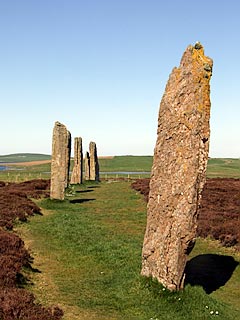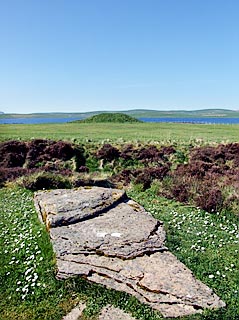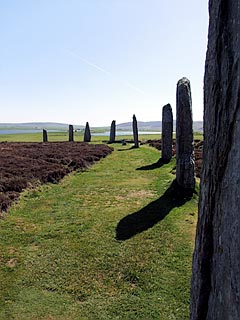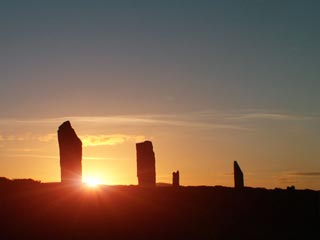
 |
 |
| Home |
| About Orkney |
| History |
| Tradition |
| Folklore |
| Placenames |
| Images |
| Downloads |
| About the Site |
| Contact |
| Links |
| Search Site |
| Awards |
| The Ring of Brodgar, Stenness | |
|
What was it used for? "..a common theory
has been that they had some connection with the religion of
the Druids, and may have been places of sacrifice."
If there is one question that is most commonly-asked regarding the Ring o’ Brodgar, and the neighbouring Standing Stones o’ Stenness it has to be : “But what was it for?” However, it’s unlikely that the stone circles had a single purpose. Just as churches today are used for various things – weddings, burials, worship, meeting places, entertainment, etc – it is likely that the stone circles served a number of roles. Because of the effort involved in their construction, its fairly safe to say that they were important to the widespread community and, as such, these roles probably revolved around religion or ritual. Theories abound - some plausible, while others verge on the ridiculous. Were they massive open-air temples? Communal meeting places perhaps? Or constructed purely as a means to map the heavens and measure the passing of time? It could be all of these, or none. Despite the claims of many, we simply can't say for certain. An astronomical observatory? The results of excavations elsewhere in Britain, together with various finds at similar sites, do seem to point to a connection with the movement of the sun and the moon across the sky. Astronomical alignments certainly seem exist at a large number of stone circles, perhaps even Brodgar, and this does add weight to the widespread theory that they were in someway used as astronomical observatories. Again, opinions on this topic vary, with as many detractors as supporters. For more details of alleged astronomical alignments at the Ring of Brodgar, click here. Professor Alexander Thom, an expert in the field of archeo-astronomy, spent several decades studying stone circles in an attempt to decipher their meaning. He discovered that not all were perfect circles - some were egg-shaped others elliptical - but whatever the shape they all seemed to show remarkable geometric precision long before the Age of Pythagoras.
At Brodgar, he felt the outlying mounds surrounding the ring were a key to this role - going so far as to say that the mounds were more important than the standing stones themselves. From the circle, Thom noted that the natural features in the surrounding landscape seemed to serve as distant markers for the rising and setting of the moon. A sightline to the cliffs of Hellia on Hoy, for example, seemed to mark the minor southern setting of the moon, while a notch on Mid Hill, to the south-east, defined the minor southern moonrise. These facts, he said, proved that the ancient Orcadians used the monuments to gain a widespread body of knowledge of the moon's movements. "The Brodgar site is the most perfect example of a megalithic lunar observatory that we have left in Britain. The ring and ditch were probably placed on this little hill at first because from here there are four far-sights marking the approximate position of the rising/setting moon at the major and minor standstills. Perhaps a thousand years later the accurate observatory was built from a cairn of earth, built with such accuracy that we can today date the observatory by the slowly changing obliquity of the ecliptic at about 1600BC. Large mounds were built so that watchers could be placed on top to warn the people below of the impending rising of the moon." However, Professor Thom was of the opinion that the Ring's 60 stones actually served the community as a sacred, or magical, ceremonial centre rather than being directly involved in the site's function as an observatory. Although there may be an element of truth in Professor Thom's theories, it must be stressed that they are not universally accepted. His critics are keen to point out that the dates he puts forward for the construction of the ring, based on astronomical alignments, are around 1,000 years later than the accepted date of the ring's construction. Ritual construction
The prestige of erecting a fine megalith, he suggested, may have been the driving force behind the development of the monuments. In his paper Rethinking the great stone circles of northwest Britain, Dr Richards, of Manchester University, challenged the long-held assumption that the monuments were intended to serve a purpose after their construction – a purpose usually assumed to be of ceremonial or of ritual or religious significance. Instead, he suggested that the act of building the monuments, in particular erecting the individual stones, was the ritually significant element and that the entire stone ring had no particular function. This, he suggests, may explain why there is a distinct lack of evidence that sites such as Brodgar were actually used. Click here for more details. Honouring the ancestors? Or were the stone circles constructed to honour the ancestors?We know that the Neolithic people participated in some form of ancester veneration, but were the stone circles part of this?
The procession from Stenness to Brodgar, therefore, could be seen as a symbolic journey from life to death. Others feel the stones themselves were erected to honour the ancestors, who, being a tangible link to the farming community's right to the land ratified their place within the islands' prehistoric society. A prehistoric meeting place? The sheer size of the Brodgar ring prompted the theory that it was designed to house the local population attending ceremonies or events. According to Aubrey Burl, the Ring of Brodgar could have held 3,000 people. He went on to suggest that the Brodgar Ring was erected because the Standing Stones of Stenness grew too small to contain the increasing number of "participants". We shall probably never know the real purpose of this enigmatic stone circle, and it's use, like our modern day churches and temples, was probably very complex. Human burials, festivals of thanks, animal sacrifice, marriage, meeting areas or pathways to the gods - all of these are possibilities. The only thing that is certain is that the Ring of Brodgar has captured the imagination of people for millennia and looks set to continue doing so for some time to come. |
A distinct lack of archaeological activity on the land immediately surrounding the Ring o’ Brodgar reinforces the idea that it was a definite "non domestic" area - a space set apart from "everyday" life. Or was the area perceived as being distinctly different and as such avoided? Click here for more details. Whether or not the Brodgar stones were used to measure the passage of time, the area in which the circle is located is ideal for the purpose. Using landmarks such as notches between the surrounding hills, it is very easy to chart the seasons from the positions of the rising and setting sun throughout the year. Professor Thom claimed to have identified a standard unit of measurement found common in stone circles - 2.722 feet - a measurement he termed the "megalithic yard". The incredible amount of manual work that went into erecting the Ring of Brodgar proves that the monument was significant enough to the builders to warrant such a massive outlay of manpower and time. |

 Thom's
conclusions were that the stone rings were definitely astronomical observatories.
Thom's
conclusions were that the stone rings were definitely astronomical observatories.  In 2004, as part of the first in-depth study
into the construction of Orkney's stone rings, archaeologist Dr Colin Richards suggested
it was not necessarily the completed stone circles that were
significant but rather the act of constructing them.
In 2004, as part of the first in-depth study
into the construction of Orkney's stone rings, archaeologist Dr Colin Richards suggested
it was not necessarily the completed stone circles that were
significant but rather the act of constructing them.  One theory is that the Ring of Brodgar
represented a symbolic area for the dead, while the Standing Stones of Stenness, with its central hearth, represented life.
One theory is that the Ring of Brodgar
represented a symbolic area for the dead, while the Standing Stones of Stenness, with its central hearth, represented life.